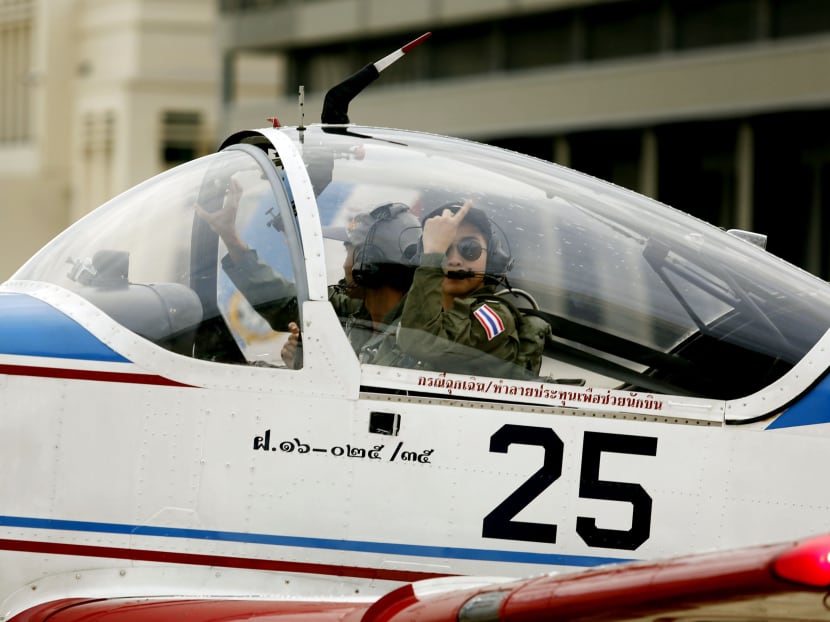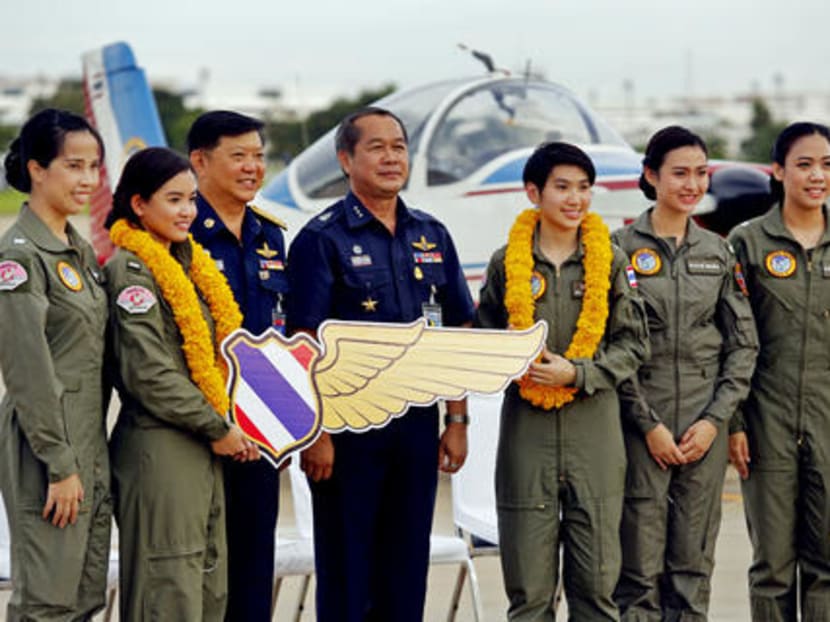Thailand’s first female air force pilots take to the skies
BANGKOK — When Ms Cholnisa Supawannapong was a little girl, one of her most anticipated daily events was seeing planes fly over her house. At the sound of an approaching aircraft engine, she would run out of her family home in Bangkok.

Ms Cholnisa Supawannapong, a member of the Royal Thai Air Force’s first all-female team. As a child, she would run outside at the sound of an aircraft flying overhead and told her parents she wanted to ‘work on a plane’. Now, she is living her dream and flying a plane for her country. Photo: Bangkok Post
BANGKOK — When Ms Cholnisa Supawannapong was a little girl, one of her most anticipated daily events was seeing planes fly over her house. At the sound of an approaching aircraft engine, she would run out of her family home in Bangkok.
“When I grow up, I will work on a plane,” Ms Cholnisa, now 24, would tell her parents every time she saw an aircraft pass overhead.
She thought hard about how she would achieve her sky-high ambitions. At first, she set her sights on becoming a flight attendant, a job that would allow her to travel the world.
For her bachelor’s degree, she studied English and Chinese at Kasetsart University to give her a competitive advantage once she began applying for jobs. That, alongside her good looks, made her seem like an ideal candidate for a flight attendant post.
But after graduation, her job hunt proved challenging. The only job she managed to land was as a member of an airline’s ground staff, which she held for a year.
Ms Cholnisa then decided to shift her goal from being a flight attendant to flying a plane.
“All I really wanted was to be able to work on a plane,” she explained. “Being a flight attendant seemed like the easiest option when I was younger. But I soon realised it was not as easy as I thought it would be. Therefore, I changed my plan to train to be come a pilot.”
She came across a one-year programme at the Civil Aviation Training Centre in Hua Hin, where she collected 215 hours of experience as a co-pilot.
After one year, she earned her commercial pilot’s licence.
Ms Cholnisa always thought she would work for a commercial airline once she got her licence. But earlier this year, she saw a recruitment advertisement for the Royal Thai Air Force, stating that it was looking to hire five female pilots.
She applied and was accepted, and now counts herself as a member of the first all-female group of pilots to work for the national air force.
FIRST FEMALE PILOTS
In February, Air Chief Marshal Treetod Sonjance, commander-in-chief of the Royal Thai Air Force Headquarters, announced a project to recruit female pilots to address the brain drain facing the national aviation industry.

(Photo: Bangkok Post)
With many aspiring pilots flocking to higher-paying foreign airlines, the air force was lagging in terms of applicants.
To qualify for the air force, applicants are required to be healthy women no more than 28 years old and at least 160cm tall. They also need to have a bachelor’s degree in science or a related field. Special consideration is given to those who already have a commercial pilot’s licence.
Ten women applied to the training programme, only two of whom were qualified commercial pilots. But with five spots to fill, the air force allowed the other women to undergo the programme. The three other women chosen were already working with the air force, but had no flight training.
Once the top five applicants were chosen, they began training in April. The two more-experienced recruits will complete their training at the end of this month and earn their full wings, while the remaining three will be trained until September next year.
TAKING UP THE CHALLENGE
From a young age, Ms Sireethorn Lawansathien, 24, learned that she was good at operating all types of vehicles. In her last year of kindergarten, she mastered the motor scooter. By the end of primary school, she could drive a car around her neighbourhood in Rayong province.
With a childhood curiosity about astronomy, she dreamt of becoming an astronaut.
However, it was a high-school field trip to an aviation school that allowed her to decide what she ultimately wanted to do — she came back and told her family she wanted to learn to be a pilot.
At first, Ms Sireethorn’s family was sceptical of the job’s viability. Her parents owned a business and expected her to take care of it once she graduated.
After some convincing by Ms Sireethorn, they agreed to support her. She went on to graduate with first-class honours.
“I wanted to be a pilot for any airline, but there were no jobs available when I first graduated,” said Ms Sireethorn. “I found one company that runs a flight simulator and was looking for a trainer. I saw the opportunity and applied for it. I got a job there and worked there for a year.”
Regardless, Ms Sireethorn wanted to fly, searching for jobs at commercial airlines in her spare time. Then, she learned about the air force’s female pilot project. Keen to be a part of history, she sent in her application.
INTO THE SKY
When Ms Cholnisa first applied to the air force programme, she thought it would be a great way to gain experience. Her family encouraged her, reasoning that government jobs were among the most stable in the country.
Among the 10 applicants, Ms Cholnisa and Ms Sireethorn had the most extensive piloting experience. Both already had a commercial pilot’s licence. Each had her first solo air force flight, which earned a half-wing.
“To be honest, I was a bit nervous before taking off without my teacher,” Ms Cholnisa confessed. “It’s a bit ironic since I am afraid of heights, but I overcame that fear as soon as my plane took off and went into the sky. It was the calmest moment I have ever experienced.”
It was not Ms Sireethorn’s first time flying solo — she was the first student in her aviation class to do so. But her experience was different this time, as she was flying a CT4B aircraft, a type commonly used in training.
When Ms Sireethorn and Ms Cholnisa enrolled in the programme, they imagined the job would mainly involve flying. However, they later learned that 70 per cent of their time is devoted to military training, while the remaining 30 per cent is set aside for actual piloting.
After completing 10 more hours of flight training, both women will have earned their full wings, meaning they will be considered fully qualified air force pilots. Next month, they will be assigned their fleet at a location they do not know yet.
“I secretly hope I get assigned to a fleet in which I can actually help people,” said Ms Sireethorn. “I want to fly the G130 and go out on rescue missions. My ultimate dream is to get to fly a fighter aircraft. But that hasn’t become available to female pilots yet.”
PREPARING FOR TAKE-OFF
Wing Commander (Wg Cdr) Wasin Tamrongrachniti, the 604 fleet commander of the Royal Thai Air Force’s Wing 6, trained Ms Cholnisa, Ms Sireethorn, and the three other women as pilots. He revealed that male and female pilots undergo the same training procedure, and noted that flying as a commercial pilot was quite different from flying a plane in the air force.
“The only real challenge is the physical issue,” Wg Cdr Wasin explained. “If your body is not fit and ready, you will have a hard time flying. Flying the aircraft air-force style is very different from flying a commercial aircraft. For example, when I took Cholnisa and Sireethorn out in the plane for their first lesson with us, they both vomited due to the pressure in their ears.”
Although Ms Cholnisa and Ms Sireethorn already had basic commercial-pilot training, it took them some time to adjust to the more “acrobatic” style of flying required in the air force.
“Being a woman is not the main obstacle at all,” Wg Cdr Wasin said. “They all proved that they can do the same things as the men can. Even though the air force does not allow female pilots to operate fighter aircraft yet, I am sure this will change in the future. We just opened our doors to females to train to be pilots this year. We might see more changes in the future.”
For any qualified woman interested in joining the Royal Thai Air Force, Wg Cdr Wasin said that everyone should prepare themselves physically as well as mentally.
“Don’t be afraid to try out,” he said. “Everyone has the potential to be anything if they really want it, like the five female pilots we are training at the moment.
“I’m sure the programme will be more popular next year, and I hope we can recruit more great pilots in the following years.”
CHASING THE DREAM
Ms Sireethorn wants to use her experience to show that one’s gender should not limit anyone’s dreams in the aviation world.
“Don’t let anyone tell you that you can’t do this or you can’t do that only because you are a female,” she said. “I want to prove that anyone can do anything as long as they stay focused and really put their mind to it.
“The most important thing is to not insult yourself by thinking you can’t do it. Try not to compare yourself with others and think you can’t do it. I can say that because I’m living proof of it. I’m not the smartest person, that’s why I work three times harder than anyone. With my ambition and focus, I can get to anywhere I want.”
Similarly, Ms Cholnisa revealed that she achieved what she set her mind to purely due to passion and hard work.
“Don’t let anything stop you from pursing your dream. If you can’t get from point A to point B directly, try the detour. You will eventually get there if you set your mind and go for it. It’s all about your mind,” she said.
Ms Cholnisa and Ms Sireethorn have already earned a half-wing each. But for the women, what is more important than the title is the fact that they get to make history as the first female pilots in the Royal Thai Air Force. BANGKOK POST









